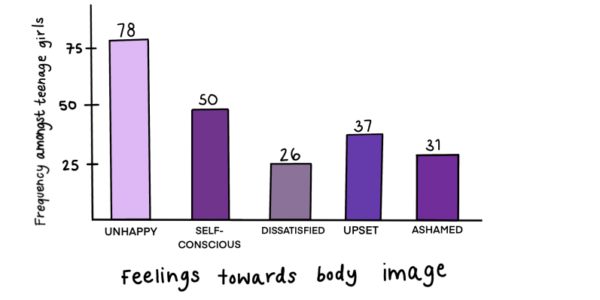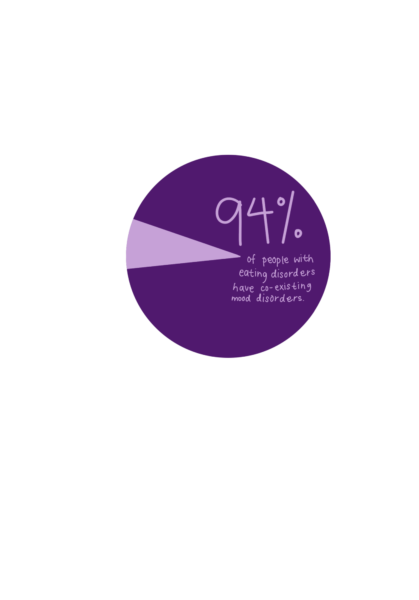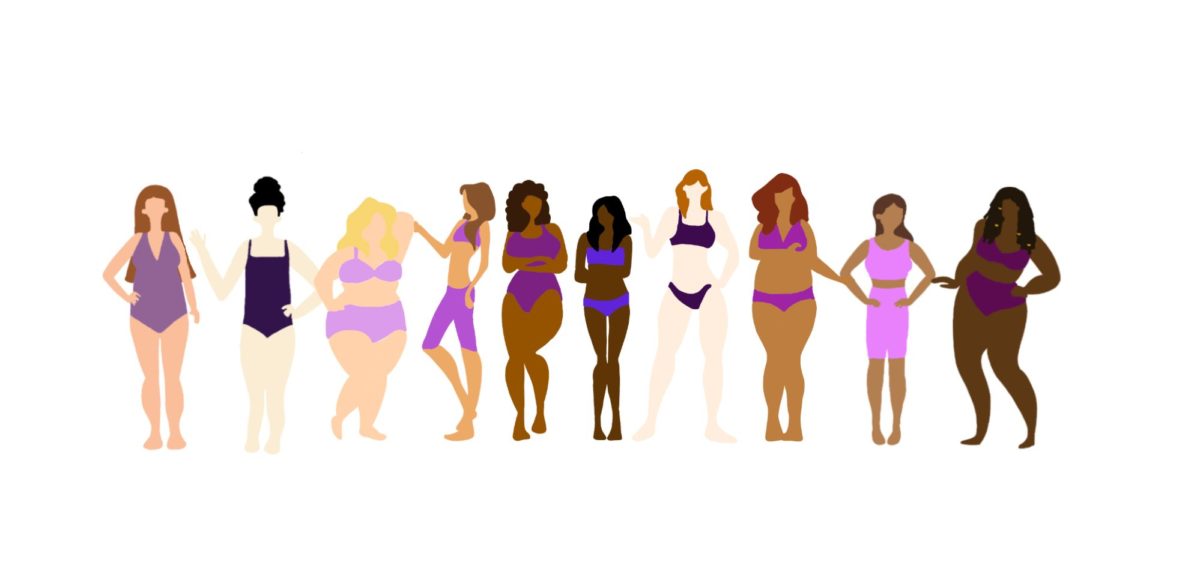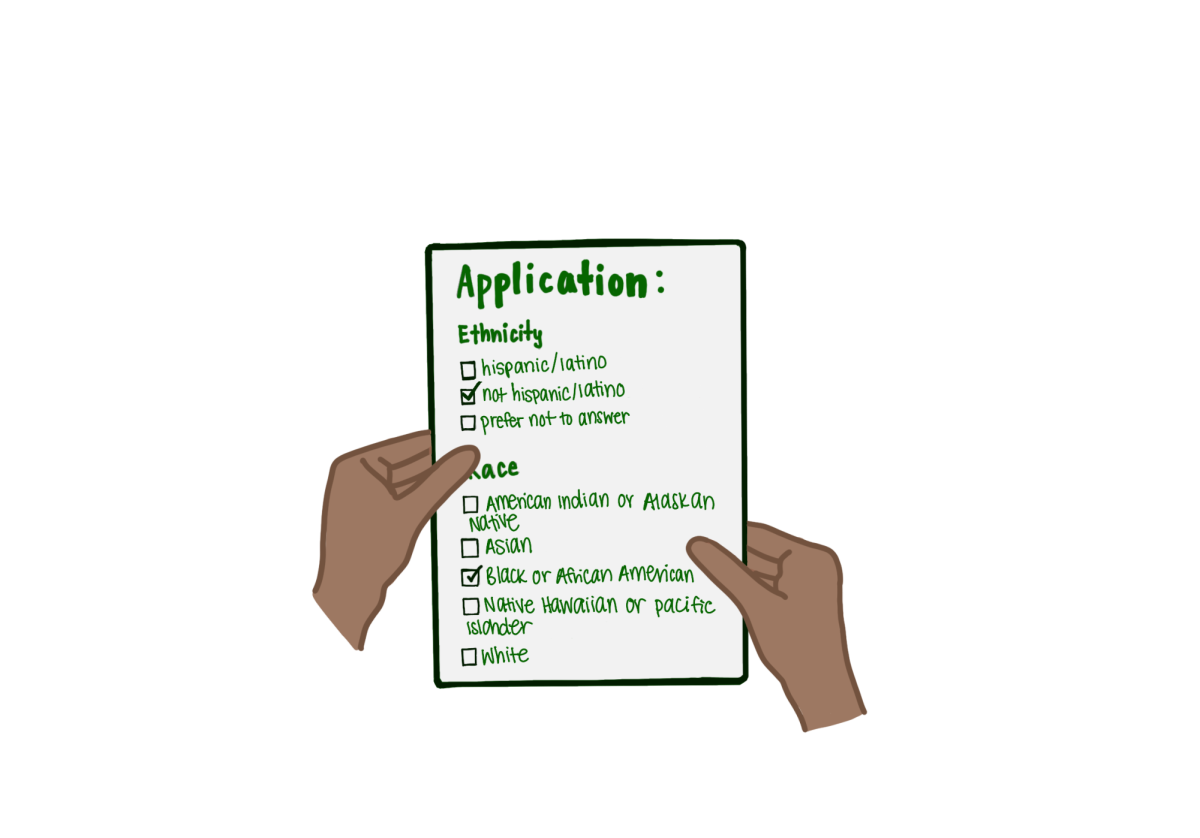This article was originally published in a print edition in September 2023.
Senior Kendall Lorton said that her struggles with body image began in the dance studio. From ages eight to 14, Lorton spent four to five hours in the studio every day as a competitive dancer, which started to gradually shape the way she viewed her body.
“I was constantly in very tight clothing, surrounded by mirrors. It was awful because in ballet especially, there’s this idea of what a ballerina should be and what they should look like,” Lorton said.
Lorton said that from a young age, she was led to believe that female dancers should have a thin and delicate body type, since this was the only representation she had seen.
“You see photos of ballerinas and you see the older girls at your dance studio and they’re all skinny, and you think ‘that’s what I’m going to be when I’m older,’” Lorton said.
A study done by the National Institutes of Health estimated that 20 to 40 % of women are dissatisfied with their bodies. Additionally, according to the National Eating Disorders Association, seven in 10 women and girls reported a decline in body confidence driven by the “pressure for perfection from media and advertising‘s unrealistic standard of beauty.”
Body dissatisfaction, constant self-comparison, and disordered eating habits have become all too common, with as many as one in five women experiencing an eating disorder before turning 40, according to Harvard Health.
Senior Perry Mirshafiei said that her dissatisfaction with her body became a driving force behind her eating disorder.
“I felt like my whole being was just the numbers on the packaging of my food instead of who I am,” Mirshafiei said. “I thought the number on the scale determined who I am and my worth, like a little price on me.”
Poor self-image can be exacerbated by the drive to meet beauty standards derived from the media, existing cultural values, and the perceived need to fit a certain box, according to multiple student and expert sources. These collective pressures have contributed to a greater prevalence of disordered eating in modern American society.
Media, Entertainment, and Culture
Janice Bremis, founder and executive director of the Eating Disorders Resource Center, said that when she was growing up in the 1960s and 1970s, she only encountered representation of thin women in TV and magazine ads.
“You’re bombarded with these images of being thin,” Bremis said, which made her think, as a child, “you can never be too thin.”
Bremis said that celebrities or other public figures who fit the beauty standard of thinness can unknowingly contribute to body dissatisfaction if they glorify unhealthy habits like under-eating or going on fad diets.
“People who are thin, like models, who are able to eat [few] calories a day, are kind of put on a pedestal,” Bremis said.
Senior Miranda Huang said that she believes the entertainment industry plays a role in shaping how teenagers view themselves and their bodies, and has created a certain set of physical features that are deemed more attractive.
“[Women] have to be a certain height, a certain weight, [and] a certain size,” Huang said. “Their thighs and [body parts] have to conform to a certain look.”
Mirshafiei said that her experiences with body dissatisfaction and disordered eating began when she started watching K-pop bands perform on television as a child.
“K-Pop idols, especially girls, are very, very skinny,” Mirshafiei said. “I always compared myself to those Korean beauty standards.”
Carrie*, a volunteer at the EDRC and a survivor of an eating disorder, said that the lack of representation of different body types shown in the media can increase one’s likelihood of developing an eating disorder.
She said that having a set standard of thinness, as traditionally propagated in most forms of American media like movies, TV, and music, has made many women and girls feel inadequate existing in their natural bodies.
“If you have a body type that’s different, you feel like you just didn’t work hard enough, or you’re broken,” Carrie said.
Karyn Cortani, another volunteer at the EDRC, said that body diversity is often lacking in Hollywood, and that certain physical features are considered to be “trendy” depending on the decade.
“They just give us the stereotypical images of the time, ‘this is what beauty is, this is what a leading lady should look like,’” Cortani said.
Sierra Filucci, the executive director of parenting content and distribution for Common Sense Media, told CNN Health that “over the course of the last 50 years, the American ideal has shifted from curvy, to androgynous, to muscular and everything in between.”
“It’s almost like when fashion goes in and out,” Carrie said, in reference to how beauty standards have evolved overtime. “It’s constantly changing and it can cause people’s perception of themselves to be very unstable.”
Carrie said that in the media there is a large emphasis placed on changing one’s looks to make oneself more desirable, causing people to “tie their looks really closely to their self-worth.”
With the rise of social media over the last decade, the rates of body dysmorphia, eating disorders, anxiety, and depression have increased in teenagers, according to Dr. Leena Khanzode, an adolescent and adult psychiatrist, and adjunct clinical faculty member at Stanford University.
“Their brains [are] not fully developed, so they can get drawn to [becoming] impulsive and obsessing over losing weight or [looking] a certain way,” Khanzode said.

Lorton said that the anonymity of social media can also allow people to harass others about their appearances, which has created a culture that scrutinizes women and girls for simply existing in their bodies.
She said she once received body shaming comments from burner accounts after posting a photo of herself that she really liked, including “whale” and “you should starve yourself.”
“They felt that since their name wasn’t on it, they could say whatever they wanted,” Lorton said. “I just think it’s so sad that people feel so bad about themselves that they have to perpetuate these awful things onto other people.”
She also said trends on TikTok and Twitter like the “girl dinner” trend, where mainly women and girls posted videos of their scant meals throughout the day, are further normalizing and spreading disordered behaviors.
“You can’t just have an iced coffee and a piece of granola for your entire day,” Lorton said. “That’s just not healthy.”
Aside from entertainment and media, societal standards and cultures specific to a country or region can impact the way that individuals view their bodies.
Mirshafiei said that from her experiences living in Iran and the United States, she feels like each country has different beauty standards, making it impossible to conform to all at once.
“Here, they want people to have a small waist and other bigger body parts,” Mirshafiei said. “But each country has its own standard.”
Mirshafiei said that when she lived in Iran, her relatives constantly made comments on the way she looked: the weight she gained or lost, or how she should aspire to look.
“Between brown people it’s really normal to tell people ‘oh, you got so chubby,’ or ‘oh, you got skinny,’” she said. “That really affected me.”
Mirshafiei said that receiving comments like those would ruin her whole day.
“I would think about it the whole day and I would cry to myself,” she said.
Along with existing cultural standards and ideals of beauty, Bremis said there is often a stigma surrounding eating disorders and body image
“You don’t want anyone to know about it,” Bremis said. “The behaviors are stigmatizing, everything about it is stigmatizing.”
Bremis said that a lot of people who are struggling tend to be “ashamed” of their experiences, which makes it harder to reach out for help.
According to NEDA, although there are similar rates of eating disorders in Asians, African-American, and Hispanics in relation to Caucasians, “people of color are significantly less likely to receive help.”
Carrie said that the media often only portrays a specific demographic of people who have eating disorders, mainly women, when in reality anyone can suffer from them.
“Maybe they think of a white, cisgender female that is really thin,” Carrie said. “That’s just not how it is at all.”
Huang said she believes that when people become trapped in the mindset that bodies are supposed to look a certain way, their mental health can start to decline as a result, and body dissatisfaction can start to increase.
“I think as human beings a lot of us strive for perfection, and we need to delineate from that norm that perfection looks a certain way,” Huang said.
Causes and Effects
According to Bremis, eating disorders often stem from a person’s environment, whether it be their household, their athletic environment, or the general society around them. Mirshafiei said another thing that factored into her eating disorder was her internal comparisons between her and her sister.
“My sister is three years older than me and she’s way skinner than me,” Mirshafiei said. “Whenever we go out, people always think I’m the older one because I’m a little chubbier, a little fatter.”
Carrie also said that generational differences can affect the conversation surrounding body image and eating disorders.
“My parents, for example, I feel like they really grew up with fatphobia,” Carrie said. “I feel like they really projected that onto us as kids.”
Lorton said that when she was younger, one of her older relatives would constantly compare her to her cousin, who was skinnier than her, while also making comments about her body.
“In their minds it’s not about being healthy, it’s about being skinny, which are two different things,” Lorton said. “I think older generations don’t understand that’s not the same thing, people can be healthy and be bigger. That’s just how they are.”
Khanzode observes that in the current climate of 2023, it may be harder for women to accept their perceived “imperfections.”
“Having a little more weight on your body or not looking perfect in the current world was much more tolerable and comfortable for my mom, compared to me, compared to my daughter,” Khanzode said.
MVHS health teacher Tami Kittle thinks that athletic environments can also be the root of adolescent struggles with self-perception.
“Sometimes coaches can be the influence of body image [issues],” Kittle said. She said people who go to the gym can start to idolize body types that are unrealistic or unattainable which can also contribute to body insecurities.
Lorton described how as a dancer she pushed her body to its limit during classes and rehearsals, often dancing for hours with few opportunities for breaks, in a way that failed to account for her physical and mental wellbeing.
“I wouldn’t have time to eat and I was just exhausted,” Lorton said. “I think a lot of dancers will use their schedules as an excuse for not eating.”
She said that the culture of competitive dance was difficult to bear at times, especially when instructors would focus their criticisms on dancer’s bodies rather than technique.
“The mirrors, the tights, the leotard, it’s so incredibly terrible,” Lorton said. “You’ll have teachers who are like ‘suck your stomach, squeeze it in,’ and it’s like, ‘I can’t squeeze my stomach in anymore, it’s just what it looks like.’”
Mirshafiei said the first time she really struggled with her body image was when she first moved to America, and everyone was comfortable with taking their clothes off in the locker rooms, which she had never experienced in Iran.
“It was really hard for me to do,” Mirshafiei said. “I felt really bad in my body.”
According to Mental Health America, eating disorders can have “long-lasting negative effects” that include impacting and impairing personal relationships.
In Mirshafiei’s case, her eating disorder affected how she interacted with people and heightened her anxiety as well.
“I was angry all the time with myself and with others,” Mirshafiei said. “I dissociated a lot. I would go into my thoughts and I would just be thinking of the numbers, numbers were all around my head.”
Mirshafiei said that during her eating disorder, calorie counting turned into an obsession that consumed much of her day-to-day thoughts.
“I would check the calories of everything on my phone before eating,” Mirshafiei said. “I was like ‘how many calories is [in] a cup of water?’”
She said her eating disorder made her physically and emotionally drained, heightening her stress and creating anxiety.
“When I would think about [eating], I would start panicking,” Mirshafiei said.
According to the National Institute for Women, 20 million women have experienced a clinically significant eating disorder at some point in their lives.
“People with eating disorders are very obsessed with what their body looks like,” Cortani said. “It compromises a woman’s ability to reach their full potential…because there’s a quarter of your brain that’s obsessed with your body and how many calories you ate at lunch.”

Issues with body image and self-perception can be a pipeline to further mental health issues, such as anxiety and depression, Kittle said. This was the case for both Lorton and Mirshafiei.
“If you’re not happy with your body, immediately your mental health is affected,” Kittle said.
Lorton said her struggles with her body image became simply exhausting.
“It drains you,” she said. “It takes over your mind.”
Bremis said that eating disorders can be life-threatening and should be treated as such, since anorexia has the highest death rate of any mental illness. She said that her eating disorder drastically impacted her daily life, and impaired her education.
“I was very sick…I had to draw back from college,” Bremis said. “I had to stop working. I was suicidal, [and] I didn’t want to live. I was so depressed.”
It was after years of struggle that Bremis was able to return to a healthy lifestyle and use her story as motivation to start the EDRC and help others work through their battles with eating disorders.
“People with eating disorders are very obsessed with what their body looks like,” Cortani said. “It compromises a woman’s ability to reach their full potential…because there’s a quarter of your brain that’s obsessed with your body and how many calories you ate at lunch.”
“Recovery is possible…it can feel really scary seeking treatment, and you don’t have to do it all at once,” Carrie said. “The first step in any kind of recovery is telling one person. If you can just do that, that’s amazing.”
Expert Opinions
Bremis said that when someone has an eating disorder, they may spend a majority of their time consumed by thoughts surrounding their body.
“I was spending 90% of my time thinking about food, losing weight, [and] exercising,” Bremis said. “My whole life revolved around the eating disorder.”
Jaimi Taylor, a licensed marriage therapist specializing in eating disorder treatment, said that eating disorders are often interconnected and interrelated to other mental health disorders.
“A lot of times, eating disorders are something that pop-up on top of pre-existing anxiety and depression as a way to try to feel better,” Taylor said.
According to the Mayo Clinic, Body Dysmorphic Disorder is a “mental health condition in which you can’t stop thinking about one or more perceived defects or flaws in your appearance.”
Khanzode said in her experiences as a psychiatrist, individuals who experience BDD have a very different perception of their bodies compared to how other people see them, and their symptoms can be exacerbated by existing beauty standards.
“If they’re not getting that feeling that [the standard is] met, that’s when they start having that distress,” Khanzode said.
According to the Body Dysmorphic Disorder Foundation, “restrictive eating may be employed to try and alter those perceived flaws.”
Bremis said that she uses a 30-30-30 ratio to describe the impacts of eating disorders on individuals who suffer from these conditions.
“30 % usually recover, 30 % have the disorder, but they can do their jobs and perform their lives,” Bremis said. “30 % just live with the illness or die.”
She also uses an acronym,“PPP” to encompass possible factors and causes of eating disorders, which stands for predisposition, precipitation, and perpetuation. Predisposition refers to when an individual has genetic or personal susceptibility to developing an eating disorder. Precipitation is when a specific triggering event promotes the onset of an eating disorder.
“Maybe you have your wisdom teeth pulled and you lose weight, and people say ‘oh, you look so good,’” Bremis said.
Perpetuation refers to when a disordered or unhealthy behavior becomes repeated for periods of time, like an addiction.
“It becomes like drug abuse or alcoholism,” Bremis said.
Taylor said that accurately identifying signs of body-image struggles can be a crucial step in the recovery journey of those struggling with eating disorders.

“A lot of [factors are] internal,” Taylor said. “But a lot of it is body comparison and dieting behavior.”
Resources and Advice
There are a multitude of resources that individuals can access if they are struggling with an eating disorder or body image issues, ranging from support groups to call lines.
The EDRC has numerous resources that adolescents can utilize based on their personal preferences and needs, and can help connect them to treatment providers including therapists and medical doctors as well as peer-led support groups for those struggling with anorexia, bulimia, or binge eating.
“The goal of the support group is to encourage each other, to seek recovery, and support each other,” Carrie said. “I feel like the most helpful thing that we do for each other is just to validate and be there.
According to Kittle, MVHS health classes take measures to protect students who may be triggered by the unit on eating habits and disorders to best support their wellbeing during class time.
“We talk about what body image is and how it is formed, body dysmorphia, anorexia, bulimia, anorexia athletica, and how these struggles are not gender specific,” Kittle said.
Kittle said she has a special policy in place for students who do not feel comfortable partaking in these types of lessons or discussions.
“For any kind of sensitive unit, I give the whole class notice if there’s going to be any triggering topics covered and tell them to email me if any of the information is going to be triggering,” Kittle said.
Taylor said that one of the biggest things that family, peers, and community members can do to help those struggling with body image issues or eating disorders is to refrain from commenting on the bodies of others, whether in a praising or critical way.
Cortani advised that friends and family members of those who struggle with disordered eating or poor self-image be as patient as possible with their loved ones, since recovery is not a linear process.
In Mirshafiei’s experience, she said that it was most important to prioritize her own wellbeing, comfort, and happiness when dealing with external influences on her body image.
“Choosing yourself, or your own comfort, or your own happiness is way more important than if someone likes you or hates you,” Mirshafiei said.
For Mirshafiei, putting herself first meant no longer weighing herself. She said that she has finally reached a point where she no longer cares what the number on the scale is.
Taylor said that it’s important to recognize when negative body image can start to lead a person down a path to disordered eating.
“You can dislike parts of your body and you can like parts of your body and have a healthy relationship with food,” Taylor said. “You can still be confident,, it’s really not an all or nothing thing.”
Huang said that it’s important to take care of body image issues day-by-day, and advised adolescents to have compassion for what their body can do rather than focusing on how it looks.
“[Our body] does a lot for us, and we don’t appreciate it,” Huang said.
Carrie said that it is important to know that recovery is possible for all eating disorders, and that there shouldn’t be stigma or shame associated with them.
“You’re not broken in any way,” she said.
From her experience, one of the most important steps toward recovery is self-love, Mirshafiei said.
“Love yourself the way you are,” Mirshafiei said. “You don’t have to lose weight or gain weight to love yourself.”








































ryan balch • Jan 28, 2024 at 12:51 am
this rocks! this is awesome! everything is awesome!